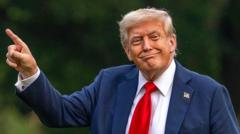US President Donald Trump recently heralded a new trade agreement with Japan as possibly the "largest trade deal in history." While this may sound grand, it is indeed the most pivotal agreement since Trump's controversial tariffs sparked market mayhem earlier this year. After extensive negotiations, Japanese Prime Minister Shigeru Ishiba expressed optimism that the agreement will be beneficial for the global economy.
As the world's fourth largest economy, Japan plays a crucial role in global trade, heavily relying on imports for energy and food while exporting electronics, machinery, and cars, predominantly to the US. Experts had previously warned that Trump's tariffs could significantly harm Japan’s economy. With the newly reduced tariffs, Japanese exporters can now enter the US market at a lower cost, alleviating recession fears and providing stability for business planning.
Furthermore, the agreement has bolstered the yen’s value against the dollar, allowing Japanese manufacturers more purchasing power for vital raw materials. Notably, the deal favors Japan’s automotive sector, reducing tariffs on car imports from Japan from 27.5% to 15%, potentially making them more competitively priced than those from China. However, US automakers voiced concerns, noting that they still face a 25% tariff on imports from their Canadian and Mexican plants—far less favorable than Japan's deal.
On the flip side, Japan has pledged to invest $550 billion in the US to enhance supply chains in sectors like pharmaceuticals and semiconductors, promises that could yield job creation and spur innovation. The US is also expected to increase its agricultural exports to Japan, specifically rice, addressing Japan’s domestic shortages while raising concerns among local farmers about competing in a shifted market.
The ramifications of this agreement extend beyond just Japan and the US; it serves as a benchmark for countries like South Korea and Taiwan, which are negotiating similar trade agreements with the US. Companies in these nations may feel heightened pressure to finalize deals, especially with an approaching self-imposed tariff deadline. Meanwhile, smaller economies like Cambodia and Sri Lanka may not benefit significantly, as they struggle to present attractive trade offers to Washington.
Though sources indicated that the US sought increased military spending from Japan as part of this deal, Japan's tariff envoy clarified that defense spending is not included. Nonetheless, steel and aluminum tariffs remain high, limiting potential US gains in those markets. Pressuring for quick agreements may lead countries to seek alternative partnerships, as seen in simultaneous negotiations between Japan and Europe aimed at creating a united front against unfair trade practices.
This trade deal could serve as a pivotal moment for Asia's economic landscape, establishing new alliances and shaping future trade negotiations across the continent and beyond.






















